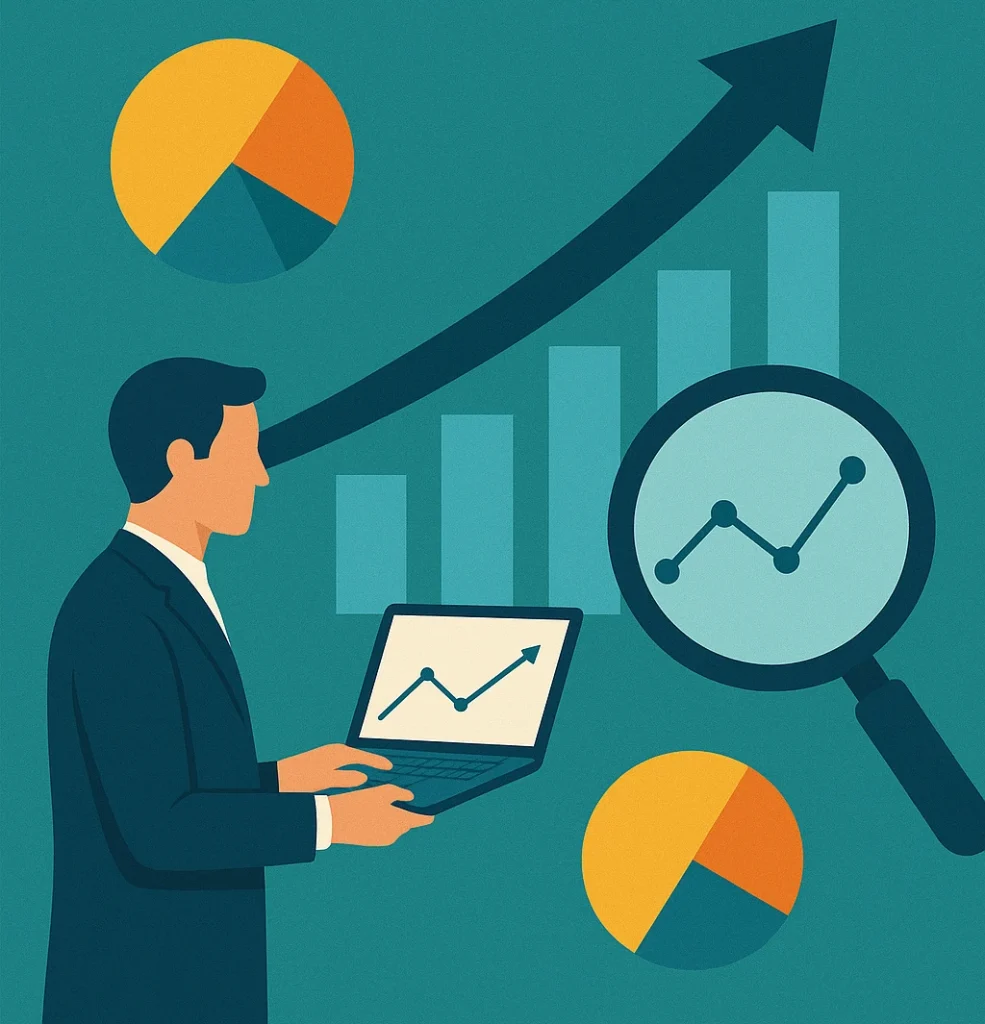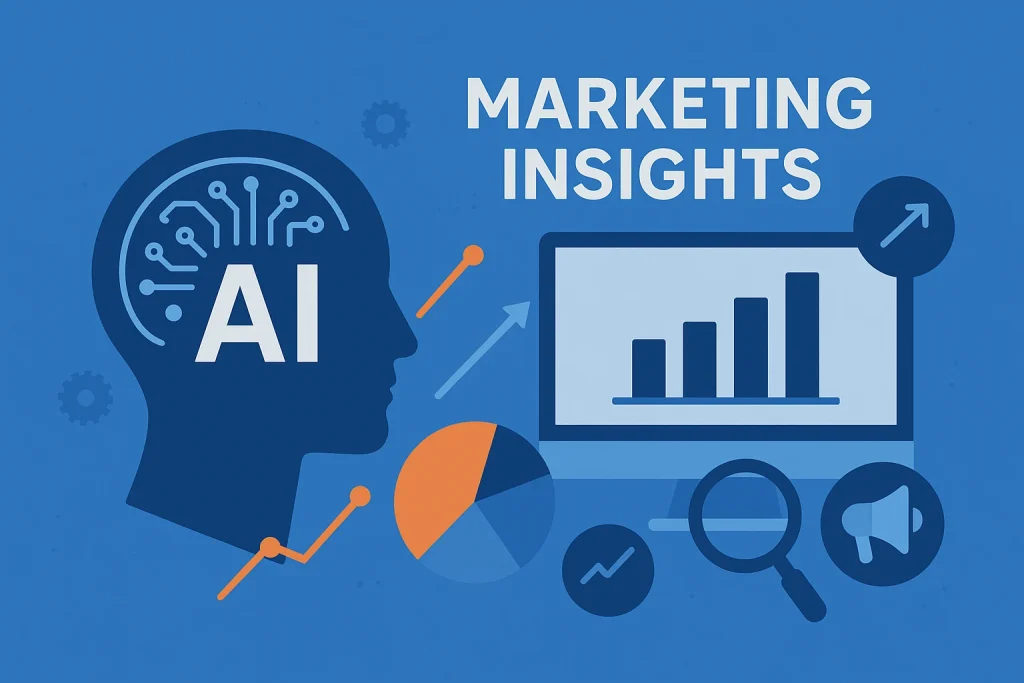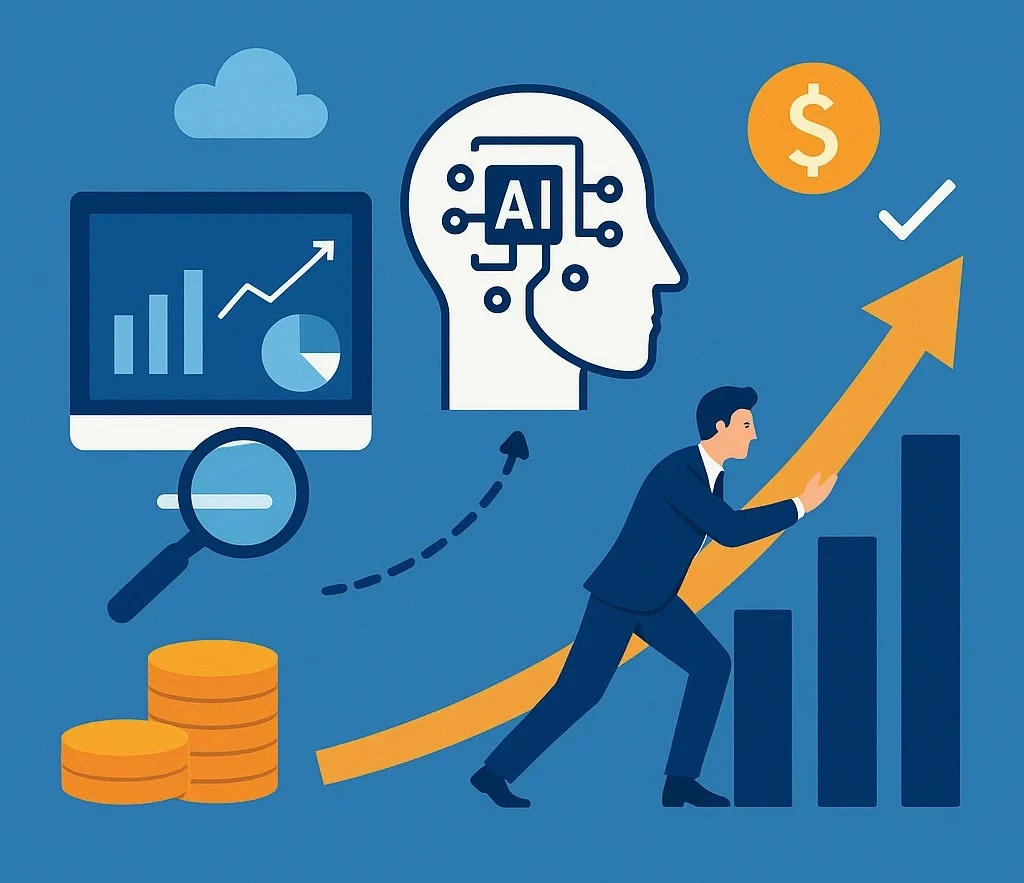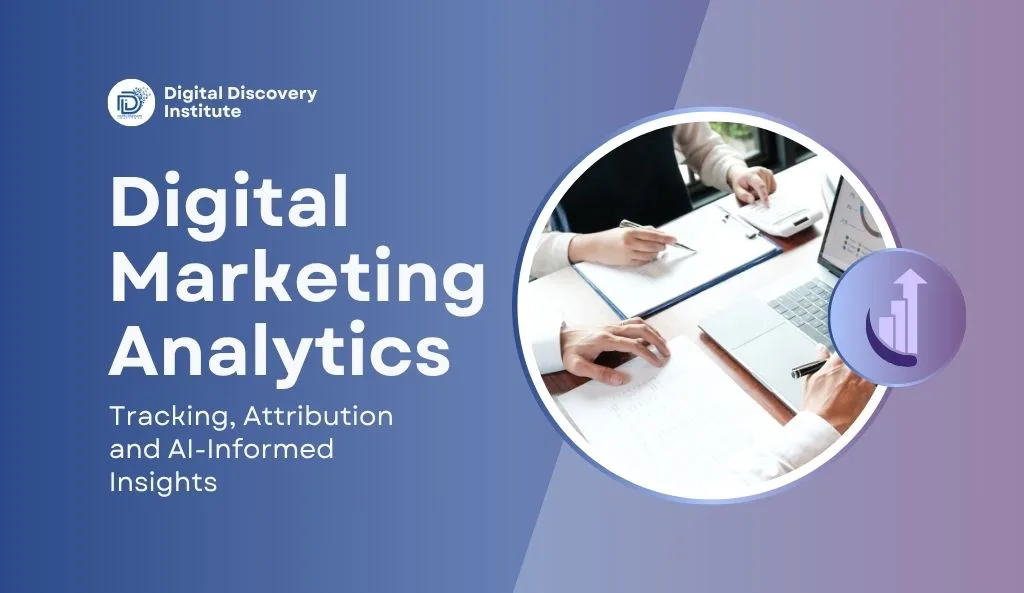Table of Contents
- Introduction: The Digital Marketing Rise of Analytics
- What Does Digital Marketing Analytics Entail?
- Tracking: The Importance of Data Tracking
- Attribution: Who Gets the Right Credit for Success?
- Artificial Intelligence and Marketing Insights
- Digital Marketing Analytics Tools
- Performance Metrics Every Marketer Should Know
- Reporting and Data Visualization
- Real-Life Example: From Data to Business Success
- Conclusion
- FAQs
Introduction: The Digital Marketing Rise of Analytics
Marketing is no longer about putting ads in the modern digital era. It has now become a data-driven ecosystem where all clicks, impressions, and conversions are tracked and analyzed.
Digital Marketing Analytics refers to the procedure which monitors, analyzes, and converts all these activities into intelligent management for marketing optimization.

Such digital-savvy training institutes as Digital Discovery Institute (DDI Mohali) don’t just teach SEO, Google Ads, and social media marketing—they also explain how marketers can optimize their campaigns using data analytics and AI-powered tools.
What Does Digital Marketing Analytics Entail?
Digital marketing analytics represents the process of gathering, computing, and clarifying data acquired through different online platforms.
Its purpose is to:
- Understand customer behavior
- Measure marketing campaign effectiveness
- Increase ROI (Return on Investment)
🔍 Main Data Sources:
- Google Analytics
- Google Ads Dashboard
- Facebook Insights
- SEO Tools (Ahrefs, SEMrush, Google Search Console)
- CRM Data and Email Campaign Reports
Through these tools, marketers identify patterns and optimize their strategies for better audience engagement.
👉 Learn advanced data tracking and analytics practically with DDI Mohali’s Digital Marketing Course.
Tracking: The Importance of Data Tracking
Tracking in digital marketing means following user activities.
When a user visits your website, clicks a button, or purchases a product, all these actions are recorded through tracking tools.
🧭 Types of Tracking:
Website Tracking:
Google Analytics and Tag Manager measure website visits, bounce rates, and user journeys.
Campaign Tracking:
UTM parameters show which ads or social posts are driving the most traffic.
Conversion Tracking:
Tracks how many users took desired actions (form fills, purchases, downloads).
👉 Students in DDI Mohali’s Digital Marketing Training learn live tracking using Google Analytics and Tag Manager in real-world scenarios.
Attribution: Who Gets the Right Credit for Success?
Marketing Attribution identifies which channel contributes most to conversions.
A customer may interact with your brand on multiple platforms — like Facebook, Google Search, and Email — before purchasing.
Attribution tells us which channel deserves the credit.
🎯 Types of Attribution Models:
- Last-Click Attribution: Full credit goes to the final click before conversion.
- First-Click Attribution: Credit goes to the channel that first brought the visitor.
- Linear Attribution: Each channel gets equal credit.
- Time-Decay Attribution: Recent interactions are given more weight.
- Data-Driven Attribution (AI-Based): Google’s AI evaluates which touchpoints were most impactful.
AI attribution is the most advanced model today, and students at DDI Mohali analyze real-world cases to understand it deeply.
Artificial Intelligence and Marketing Insights
Artificial Intelligence (AI) is transforming how data is interpreted in marketing.
It’s no longer limited to automation—it’s about generating insights and predictive decisions.

How AI is Changing Digital Analytics:
- Predictive Analytics: AI predicts which users are most likely to convert.
- Customer Segmentation: Machine learning algorithms divide audiences into unique behavioral groups.
- Automated Reporting: AI creates smart marketing reports and insights automatically.
- Anomaly Detection: If campaign performance drops suddenly, AI tools alert marketers instantly.
In DDI Mohali’s AI in Digital Marketing Course, students learn analytics using ChatGPT, Google Gemini, and Meta AI, applying AI-driven insights to real business cases.
Digital Marketing Analytics Tools
Below are some popular tools every digital marketer should know:
| Category | Tools |
| Web Analytics | Google Analytics 4, Matomo |
| SEO Analytics | Ahrefs, SEMrush, Moz |
| Social Media | Meta Business Insights, Hootsuite |
| Paid Ads | Google Ads, Bing Ads Dashboard |
| AI Analytics | Google Cloud AI, ChatGPT for Analytics, Looker Studio |
These tools enable students and marketers to make data-backed, measurable, and profitable decisions.
Performance Metrics Every Marketer Should Know
| Metric | Meaning | Ideal Focus |
| CTR (Click-Through Rate) | How many users viewed and clicked your ad | High CTR = Better Engagement |
| Bounce Rate | % of users who left without engaging | Lower bounce rate = Better UX |
| Conversion Rate | % of visitors completing a goal | Higher = Better ROI |
| ROAS | Return on Ad Spend | 3x and above is ideal |
| CLV | Customer Lifetime Value | High CLV = Long-Term Growth |
Students at DDI Mohali learn to analyze these metrics through live campaigns and Google Analytics dashboards.
Reporting and Data Visualization
One of the biggest advantages of analytics is that it makes complex data visual and easy to interpret.
Tools like Google Looker Studio, Power BI, and Tableau allow marketers to create attractive and comprehensible dashboards.
In DDI Mohali’s Digital Marketing Analytics Module, students build their own live dashboards using Looker Studio and real campaign data.
Real-Life Example: From Data to Business Success
Suppose a student creates a blog website after learning website development and SEO at DDI Mohali.
He uses Google Analytics to track his site’s performance and notices that 80% of visitors come from mobile, but the bounce rate is high.

Using these insights, he optimizes the site’s mobile interface, improving engagement and conversions.
This demonstrates how digital marketing analytics drives business growth through informed decision-making.
Conclusion
Digital Marketing Analytics is the backbone of modern marketing.
From Tracking to Attribution and AI-driven Insights, every step empowers marketers to make smarter decisions based on data.
By mastering tools like Google Analytics, Looker Studio, and AI automation, marketers can enhance campaign performance and maximize ROI.
At Digital Discovery Institute (DDI Mohali), students gain hands-on training in SEO, AI marketing, analytics, and website development, preparing them to become data-driven strategists in the evolving digital landscape.
FAQs
What is Digital Marketing Analytics, and why is it important?
Digital Marketing Analytics helps track, measure, and optimize marketing performance. It enables businesses to understand customer behavior, identify top-performing campaigns, and improve ROI. Institutes like DDI Mohali provide practical analytics training using Google tools and AI platforms to help students interpret real data effectively.
What tools are essential for learning analytics?
The top tools include Google Analytics 4, Looker Studio, SEMrush, Ahrefs, and Power BI. Students at DDI Mohali practice these tools in live projects to understand website traffic, SEO performance, and audience behavior through real-world data tracking.
How does AI influence digital marketing analytics?
AI tools like ChatGPT, Google Gemini, and Looker Studio use predictive analytics to forecast customer behavior, identify trends, and automate reporting. DDI Mohali’s AI Marketing Course teaches students to use these technologies for strategic decision-making.
What are Attribution Models in digital marketing?
Attribution models determine which channel deserves credit for a conversion. The main models include Last-Click, First-Click, Linear, Time-Decay, and AI-based Data-Driven Attribution. Students at DDI Mohali learn all these models with real case studies in their analytics curriculum.
What is Conversion Tracking, and how does it work?
Conversion Tracking measures how many users take a specific action (buy, sign up, or download). It’s crucial for assessing marketing success. DDI Mohali’s Digital Marketing Course provides live training on conversion tracking through Google Ads and Tag Manager.
What are the key performance metrics in digital marketing?
CTR, Bounce Rate, Conversion Rate, ROAS, and CLV are vital metrics. These indicators help marketers evaluate engagement, cost-efficiency, and customer retention. DDI Mohali emphasizes these metrics in their practical performance marketing modules.
What role does data visualization play in marketing analytics?
Data visualization simplifies complex analytics into interactive graphs and dashboards. Using Google Looker Studio and Tableau, students at DDI Mohali learn to design real-time marketing dashboards for client reporting and business decisions.
Why should one learn analytics from DDI Mohali?
DDI Mohali is one of the best digital marketing institutes in Mohali offering AI-powered analytics, SEO, Google Ads, and real-time tracking modules. It combines classroom training with live internship opportunities for holistic learning.
What career options are available in digital marketing analytics?
Careers include SEO Analyst, Data Strategist, Marketing Data Consultant, and Performance Marketing Manager. With hands-on analytics training from DDI Mohali, students secure strong placements in top companies.
How can I enroll in the Digital Marketing Analytics course at DDI Mohali?
You can enroll by visiting Digital Discovery Institute’s website or calling +91-70876 02319. The institute offers advanced modules in analytics, SEO, and AI-driven marketing, with guaranteed internship opportunities.


